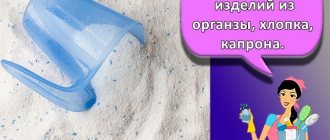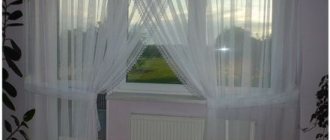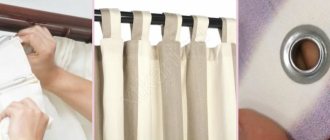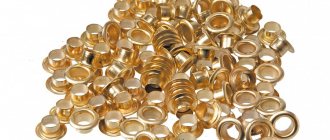Features when bleaching tulle made from different materials
The choice of method for bleaching curtains at home depends on the material from which the curtains are made. Window tulle is made from organza, viscose, nylon, and cotton. Often made in the form of mesh or lace. This is a thin material that cannot be exposed to aggressive substances and hot water.
Whitening recommendations:
Cotton fabric is the most durable material that will not be damaged by chlorine bleach and boiling. However, tulle is an airy fabric, so you should not abuse aggressive methods.
Synthetics shrink from hot water. For whitening, homemade recipes with peroxide, ammonia, brilliant green and other substances are suitable. Can be washed in a machine on a delicate cycle using gentle detergents.
Curtains made of nylon, chiffon, silk, organza are recommended to be washed by hand with the addition of special products for thin fabrics. Oxygen bleaches can be used. It is unacceptable to wash in hot water and wring out with twisting.
The suitable temperature for bleaching tulle is 30–40 °C. Regardless of the washing method, the fabric should not be wrung out.
Useful tips
To maintain their original snow-white appearance, curtains need to be carefully and constantly looked after. The following tips will be useful for this.
Recommendations for caring for tulle:
- Before soaking, the tulle must be dusted off so that the dirt does not spread and stain the fabric even more.
- To wash curtains made of synthetic fabrics, use only cold water; in hot water, stains are fixed, and the curtains can shrink.
- Before washing and soaking, fold the fabric carefully. Otherwise, folds and creases will appear that will be difficult to iron out.
- Adding a tablespoon of vinegar when washing will add shine to the fabric.
- Tulle curtains do not need to be ironed after washing, you just need to gently wring them out and hang them wet on the curtain rod, they will straighten themselves.
- Before washing in the machine, be sure to check the drum for any colored items left behind, so as not to accidentally stain the curtains.
- When washing colored curtains, avoid high temperatures and powerful chemical stain removers so as not to wash the dye along with the stains.
- Curtains should only be ironed from the back and on medium setting.
- If you couldn’t wash your favorite curtains, you can redye them using professional aniline-based dyes.
By applying these simple recommendations when caring, you will be able to preserve the original appearance of the fabric for a long time.
How to bleach tulle
Ready-made and folk remedies are suitable for washing and bleaching. The first are industrial oxygen-based bleaches. Suitable for most delicate fabrics. Oxygen bleach removes yellow stains, removes stains, and gets rid of gray color. Add to soaking water according to instructions. It is better to use liquid bleach: it dissolves more easily and is washed out of any fabric.
It is better to soak delicate fabrics with gentle home remedies:
- Nylon tulle is bleached with hydrogen peroxide, salted water or brilliant green.
- Cotton can be washed with soap and soaked in starch.
- The organza will turn white when exposed to ammonia and peroxide.
- Flax will withstand boiling with soap shavings. It bleaches well with ammonia.
- The veil cannot be “poisoned” with household chemicals. Starch or ammonia are suitable for bleaching.
It is not recommended to use “Belizna” and other chlorine-containing products. Chlorine will corrode fine fibers. Cotton can be washed occasionally.
How to bleach organza from gray
Bleaching with brilliant green
What to cook?
- Zelenka;
- cup;
- pelvis
What to do?
- Stir 5-10 drops of greenery in a glass of warm water and leave it for a few minutes.
- Evaluate the result - if you do not see any sediment, the solution is ready and can be poured into a basin for rinsing (7-10 liters of warm water).
- If there is still sediment, mix the contents of the glass well again or strain it before “sending” it into the basin.
Place the tulle, previously washed in the usual way (by hand or in a machine), in a basin with a solution of brilliant green and leave there for 3-5 minutes, turning the material over a couple of times. Hang the curtain and let it drain.
Pros and cons of the method
- Zelenka is in every home medicine cabinet.
- Brilliant green solution is very cheap compared to household chemicals.
- Returning the color to tulle takes a minimum of time.
- If you do not mix the greenery well enough, the material will not acquire a snow-white hue, but light green stains, which are quite problematic to remove.
How to bleach tulle by hand
To make the curtains snow-white, it is not necessary to use expensive products and run the machine. The dust will come off in soapy water in a couple of minutes. Homemade bleaches will refresh curtains.
How to bleach and remove yellowness with laundry soap
One of the simple and effective ways to whiten curtains. It is necessary to grate the soap bar on a fine grater, and then completely dissolve the shavings in warm water. A dusty curtain is immersed in a cloudy solution and left for 2 to 8 hours.
Laundry soap also removes stains. Dirty marks are lathered locally and left for several minutes. For best effectiveness, it is recommended to place the treated tulle in a plastic bag and tie it. After a couple of hours, the fabric is washed.
Soap perfectly removes traces of soot and grease, and returns the color to a gray curtain. It is recommended to bleach nylon that has turned yellow from the sun with soap.
How to bleach synthetic tulle with salt
A cheap and simple method that is suitable for natural and synthetic fabrics. The salt solution will draw out dust and add shine. How to use:
- Remove the curtain from the curtain rod and shake it well.
- Fill a basin or bathtub with warm water.
- Dissolve salt at the rate of a tablespoon per liter of water.
- Add 100 g of washing powder.
- Immerse the material in the resulting mixture.
- Let it sit for 4–8 hours depending on the amount of dirt.
- Wash with soap or liquid powder.
Nylon is bleached a little differently. Salt is poured into water at room temperature (1.5 tablespoons per liter). Nylon curtains are immersed in the resulting solution and left for 15 minutes. Then you need to rinse the material several times in clean water and leave it on the edge of the bath to drain off excess moisture.
You can bleach a yellow cotton curtain with salt and soda. First, the curtain is soaked in soapy water. When the dust and most of the dirt are gone, the curtain is immersed for 2-3 hours in a soda-salt solution (two tablespoons per 5 liters of water). Afterwards, rinse and hang to dry.
Salt does not cause allergies, so it is suitable for bleaching curtains in a children's room.
How to bleach nylon and organza with brilliant green
Brilliant green perfectly removes yellowness even from capricious fabrics, such as organza. Before bleaching the tulle with green paint, you must first wash the curtain. First, the dust is shaken out, then the curtain is soaked in soapy water for 5–8 hours. Afterwards it is washed by hand with soap, gel or liquid powder. During the last rinse, green stuff is added:
- Add 15 drops of brilliant green to a glass of water.
- Leave to infuse for 5-7 minutes.
- Stir and leave for another 5-7 minutes until the sediment disappears.
- Add to a bowl of clean water to create a solution with a barely noticeable green tint.
- Immerse the curtain and leave for 10 minutes (turn occasionally).
- Rinse and hang to dry.
To enhance the effect, before rinsing with greenery, the material can be soaked in a saline solution for 2–3 hours. Prepared at the rate of 5 tablespoons per liter of water. During the entire procedure, only cool water up to 40 °C is used.
A large amount of greenery will give the product a greenish or turquoise tone. Therefore, it is important to accurately observe the proportions. There should be no sediment in the solution that will transfer to the fabric.
How to restore whiteness with salt, peroxide and ammonia
A fairly effective method to bleach synthetic material. The solution will not remove stubborn dirt, but it can significantly refresh a tarnished curtain.
How to cook:
- Immerse the curtain in soapy water, leave for two hours, and rinse.
- Wash by hand with soap.
- Dissolve 6 tablespoons of salt and 50 g of washing powder in 10 liters of water.
- Add a tablespoon each of ammonia and peroxide.
- Place tulle in the solution and leave for 5–8 hours.
- Rinse well and hang to dry.
How to remove yellowness with soda and boric acid
It is better to use boric acid in powder form. The solution is prepared for soaking before the main wash. This method will help to bleach the yellowness of synthetics and refresh an old curtain.
How to prepare the solution:
- Add soap to a bowl of water.
- Add a tablespoon of soda and 10 g of boric acid (1 sachet).
- Immerse the curtains and leave them for a day, turning them over periodically.
- Drain the dirty water and wash the tulle by hand as usual.
To bleach stained cotton, you can increase the concentration of acid and soda by 2-3 times.
How to quickly bleach with peroxide and alcohol
This is the fastest way to bleach cotton. What should be done:
- Pour warm water (60 °C) into a basin.
- Dissolve 3 tablespoons of hydrogen peroxide.
- Add a tablespoon of alcohol (you can take vodka).
- Stir and immerse the material in the liquid.
- Wait for half an hour.
- Rinse, wait for excess moisture to drain, and hang to dry.
Similarly, it is recommended to bleach nylon tulle with peroxide and alcohol. However, it must be kept in cold water (20–30 °C).
How to tint tulle with blue
If you can’t bleach it white, you can tint yellowish curtains. Blue powder is added to washed items to impart a bluish tint and refresh the fabric. How to prepare the solution:
- Add a teaspoon of blue water to 10 liters of warm water.
- Mix thoroughly so that there are no lumps or sediment left.
- Dip the curtain and turn it over several times to distribute the paint evenly.
- Rinse the curtain with clean water.
If you overdo it with bluing or mix it poorly, bluish stains will remain on the fabric. Should not be kept for a long time.
How to bleach cotton and veil with starch
The product is most often used to bleach cotton. After use, the tulle will keep its shape for a long time. In addition, starch creates a protective film, making the material less contaminated.
How to whiten:
- Clean the material from dust and soak in soap and water.
- Dissolve potato starch in water (a tablespoon per liter).
- Immerse the curtains and soak for 5–6 hours.
- Rinse to remove excess starch and leave to dry.
It is necessary to completely dissolve the powder so that no lumps remain. A large amount of starch will make the tulle stiff.
How to bleach an old curtain with soda
Natural bleach will return a snow-white appearance to even old tulle. How to whiten:
- Dilute two tablespoons of soda in 10 liters of water.
- Immerse the item so that the solution completely covers the fabric.
- Leave for 2-3 hours.
- Rinse several times in clean water.
A combination of baking soda and washing powder will remove grayness from tulle. Both ingredients must be diluted in 5 liters of warm water. The tulle curtain is immersed in the solution and left for 2–3 hours. Then it is washed several times with clean water.
To bleach thin fabrics, it is necessary to mix the soda thoroughly so that no large grains remain that can damage the material.
Bleaching with table salt
What to cook?
- 3-5 tablespoons of table salt (the most common - coarse);
- washing powder (not necessarily bleaching);
- pelvis
What to do?
- 1 Dissolve the salt and powder in warm water and immerse the tulle that has lost its whiteness in the resulting solution.
- 2 Leave it to soak for at least 3-4 hours (ideally overnight).
- 3 For heavy soiling, machine wash the fabric; for light soiling, simply rinse well.
- 4 For “prevention”, washed tulle can be rinsed in a saline solution after washing for several minutes.
Pros and cons of the method
- High-quality whitening will cost you a few rubles.
- You don’t have to look for salt specifically – it’s in every kitchen.
- This method can be used to wash children's curtains - salt is not an allergen.
- Salt bleaching will take several hours.
How to bleach tulle in an automatic washing machine
It is recommended to bleach a yellowed curtain with dirty marks in the washing machine. This will make the task much easier. A washing bag or an old pillowcase will protect the fabric from snags and tears.
The drum should not be packed tightly; the fabric should rotate freely. This way it will bleach evenly and wash better.
Preparing for whitening
Before washing in the machine, you need to shake the curtain over the bathroom or in the yard.
It is recommended to soak stained or greasy fabric first in soapy water.
Obvious stains can be washed with bleaching soap and left for 30–60 minutes. After all procedures, the curtain must be rinsed and placed in a drum.
You should not immediately start bleaching dirty curtains. The gray will most likely disappear, but the stain marks will remain.
Choice of product
It is best to bleach curtains in a machine using oxygen bleach, which is poured into a special compartment. It is suitable for any fabric.
You can bleach nylon with ammonia. To do this, you need to add a couple of drops to the powder compartment. An alternative option is peroxide tablets (5-10 pieces). It is recommended to bleach a chiffon or organza curtain with salt. A tablespoon of crystals is mixed with detergent. The shine will be given by vinegar, which is poured into the conditioner compartment.
You can add conditioner to synthetics. It will make the curtains thicker and remove static electricity.
Which mode to use
The choice of mode depends on the density and composition of matter:
- natural material – “Cotton” mode up to 60 °C;
- synthetic tulle – “Synthetic” mode, “Delicate wash” at 30–40 °C;
- lace, flowing fabrics – “Silk”, “Wool” mode up to 40 °C.
To whiten nylon curtains, you need to set the delicate mode to 20–30 °C. The number of revolutions should not exceed 600.
It is recommended to turn off spin for any fabric. Otherwise, the output will be a compressed lump that will be difficult to smooth out.
How to wash tulle in a washing machine
Blue bleaching
What to cook?
- Blue;
- pre-washed tulle.
What to do?
- 1 Wash by hand. Dilute half a teaspoon of blue in 7-10 liters of warm water, make sure that there are no “lumps” in the solution (they can leave stains on the fabric). Rinse the tulle thoroughly, first with blue, and then in clean water.
- 2 Washing in an automatic machine. Place the material in the drum and add your regular laundry detergent. Instead of conditioner or rinse aid, use blue in small quantities (1-1.5 caps).
Pros and cons of the method
- The whitening process does not take much time.
- As a result, the tulle becomes truly snow-white.
- Finding bluing in supermarkets or chain stores of household chemicals today is almost impossible - the search for “bleach” can take a long time.
- If you don't mix the powder thoroughly enough, difficult-to-remove stains will remain on the fabric. It is for this reason that it is better to rinse blue tulle manually - some machines “sin” by insufficiently dissolving the bleaching agent (whole pieces can get directly into the drum).
Rules for drying and ironing
The tulle does not need to be twisted, wrung out or dried in the machine. It is enough to wait for the excess water to drain, and then hang it on the curtains. In just half an hour, the curtain will dry and straighten under its own weight.
If there are any creases on the bleached tulle, you can iron it with an iron at the lowest temperature. To prevent thin fabric from melting, it is recommended to iron it through gauze.
Knowledge about the composition of the fabric will help you bleach tulle correctly. Thin and synthetic fabrics require gentle bleaching methods. It is best to wash them by hand in cool water. Natural thick curtains can be bleached with bleach in hot water, but it is better not to abuse such methods.
Whitening with ammonia and hydrogen peroxide
What to cook?
- Ammonia;
- 3% hydrogen peroxide.
What to do?
- 1 Add 1 spoon of alcohol and 2-3 spoons of peroxide to a bowl of water heated to 60 degrees, mix the solution well.
- 2 Dip the tulle in it for half an hour.
- 3 After this time, rinse the fabric well, wring it out without twisting, and hang it to dry.
Pros and cons of the method
- Cheap: one whitening treatment costs less than 10 rubles and still gives excellent results.
- You will spend a minimum of time on washing - no overnight soaking is required.
- This method should only be used for bleaching cotton materials.
Are whitening and modern bleaches effective?
It is not for nothing that we did not mention in the main material about traditional whiteness and modern bleaches, which, according to manufacturers, use innovative formulas.
Undoubtedly, the listed means give excellent results and, importantly, do not require a lot of time to achieve them. As a matter of fact, this is where their advantages end.
Whiteness literally “destroys” the fabric and after 2-3 uses, thin tulle can tear from any careless movement.
In addition, after the second wash with white, the material does not acquire a snow-white tint, but a shade close to yellow.
The same applies to innovative products: having a considerable cost, they give excellent results only the first time they are used.
Why does tulle turn yellow?
Over time, tulle acquires an unpleasant yellow tint under the influence of the following external factors:
- direct sunlight;
- grease and soot from the kitchen;
- tobacco smoke;
- proximity of heating radiators;
- washing powder residues due to insufficient rinsing;
- particles of exhaust gases penetrating from the street;
- dust remaining before soaking;
- washing (for example, when using too hot water for synthetics).
To maintain the whiteness of tulle or return it to its original appearance, regular and proper washing with bleaching agents is required.
Whiteness with starch
What to cook?
- Starch;
- large container (basin or bucket).
What to do?
- 1 Clean the tulle from dust, and if it is heavily soiled, wash it in the machine as usual.
- 2 Place the prepared material in a bowl of warm water, in which 250 grams of ordinary starch have been thoroughly mixed.
- 3 Leave the curtains in the solution for 5-6 hours, then hang them without wringing them out.
Pros and cons of the method
- Minimum cost of whitening
- Starch can be found in any store.
- The tulle will not only become snow-white, but will also keep its shape well.
- You'll have to spend several hours.
Modern remedies for grayness and yellowness
Several types of bleaches are suitable for curtains:
- chlorine-containing;
- oxygen;
- optical.
Chlorine-based bleaches have been used for a long time. This group includes the common remedy Whiteness. Such substances act quickly, but give short-lived results. Chlorine quickly destroys the structure of the fabric, the threads become thinner, and yellowness quickly returns.
Oxygen bleaches (for example, Vanish) clean much more gently. They do not damage the structure of the material. You can easily use them more often than chlorine-containing analogues. However, substances such as stain removers are marketed. To properly bleach gray textiles, follow the instructions.
The procedure is carried out by hand washing; it is often necessary to soak the item in the prepared solution or apply the substance directly to the material. Among the disadvantages of oxygen bleaches is their short duration of action. After just a few washes, you will have to look again for methods to rid tulle of grayness.
Optical brighteners return whiteness to things or enhance the brightness of white fabrics due to their ability to absorb ultraviolet radiation in the range of 300-400 mm. The rays are converted into light with a blue tint, the wavelength is 400-500 mmk. The perception of once gray things changes due to compensation for the deficiency of blue rays. The technology is suitable for natural and synthetic materials.
Bleaching with potassium permanganate
What to cook?
- Potassium permanganate;
- laundry soap (72 percent);
- pelvis;
- cup;
- grater
What to do?
- 1 Finely grate 100 grams of soap and stir the resulting mass in warm water.
- 2 Dissolve a small amount of potassium permanganate in a glass of water, make sure there is no sediment and pour the resulting solution into a basin. The result should be slightly pinkish water with a small amount of soap suds.
- 3 Soak the tulle in the basin for half an hour and wash it in the usual way (by hand or in a washing machine).
Pros and cons of the method
- Excellent results that last quite a long time.
- Minimum time spent.
- Finding potassium permanganate today is quite difficult.
Why does tulle darken?
Everyone at some point is faced with the fact that purchased snow-white curtains quickly lose their freshness and acquire a yellowish or grayish tint. This is facilitated by:
- Dust - especially in those rooms where the windows “look” onto the road.
- Kitchen soot, grease deposits and cigarette smoke.
- Bright sunlight.
- Pets and small children “help” this.
- Frequent touching of hands - with constant movement of the curtain.
- Soot and ash particles in rooms with stove heating.
Time is also a factor affecting the color of threads.
Features of bleaching depending on the fabric
Let's look at the subtleties of bleaching different types of tulle fabric.
Capron
Curtains made of nylon tulle are usually very thin. Because of this, they wrinkle a lot and are very sensitive to adverse effects (including chemical ones). Such properties require the use of the most gentle color restoration method.
In this case, starch is ideal. Not only is it able to restore whiteness, but after soaking in a starch solution, the curtains become a little stiffer, which is especially true for nylon curtains.
Nylon
Nylon tulle differs in properties from nylon tulle. First of all, it's not that sensitive. Secondly, pollution is more easily absorbed into it. This requires the use of stronger curtain cleaners. Green and blue are perfect for this procedure.
If you are still afraid of damaging the curtain, you can use a more gentle bleaching method - salt. When using it, you don’t have to be afraid that any harm will be done to the canvas.
Veil
The main property of voile tulle is its relative density. Although it looks very airy, literally weightless, in reality there is very little distance between the individual threads. Therefore, dirt eats into the material much more strongly. This requires more radical cleaning. Therefore, ammonia and hydrogen peroxide are used.
Chiffon
Chiffon is a rather delicate material. Therefore, to clean it from contaminants, you need to use the most gentle methods:
- soda;
- salt;
- laundry soap.
Jacquard
Due to the fact that jacquard tulle has massive patterns, it is quite durable. Thanks to this, it tolerates all whitening methods well.
Jacquard often requires boiling because microscopic dirt particles get stuck in the thicker patterned areas where other methods cannot clean them.
Tulle
Recommendations
Here are some recommendations for washing tulle and other manipulations with this material.
- After washing, the tulle is not folded, but hung on a curtain rod. This will give it the correct shape, which will make ironing much easier in the future.
- The tulle is ironed until it remains slightly damp. This ensures the best smoothing of the fabric.
- It is better to iron the seams using a damp cotton lining. Otherwise, the curtain can be burned.
- Tulle curtains should never be wrung out. Otherwise, there will be creases and barely noticeable lines on them. It looks very ugly.
- When working with chlorine-containing bleaches, ammonia and hydrogen peroxide, you must prevent these substances from getting on your lips, eyes, other mucous membranes, or wounds. This can cause severe irritation.
- Even when washing by hand, the water temperature should not exceed 40 degrees Celsius. For very heavy contamination, it can be increased by no more than 5 degrees.
Iron











